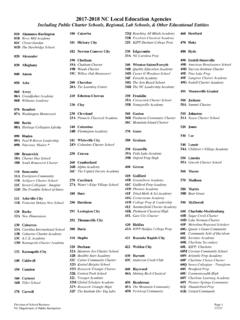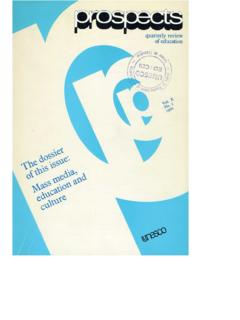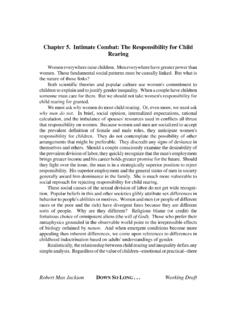Transcription of A Concise History of the British Mod Movement
1 A Concise History of the British Mod Movementby Melissa M. CasburnEmerging from World War II, the youth of London found themselves in a period of traditional values, con-formity and drabness. Struggling to escape the oppressiveness of morals, family obligations and strict dis-cipline in schools and on the streets, a string of youth subcultures emerged as a way of rebellion and self-expression, beginning with the Bohemians, and continuing today with punks and skin-heads. Somewhere in the middle lie the Mods, an immeasurably large and widespread cult of fashion-worshipping working-class teens with money in their pockets and time on their immediate predecessors of the Mods were the Teddy Boys or the Teds. In an attempt by the shop-owners of Saville Row to reincarnate the dandy look, Teddy Boys sported drape jackets with drainpipe trousers or jeans, the distinctive uniform.
2 An extremely narcissistic group, the only violence that ever arose in relation to them was due to an over-reaction to insults about their mode of dress; one common insult being flash cunt . The Teds cultivated a slick image, completed by a greasy, Bryl-creamed quiff , a Fonzie-style lock hanging down the center of the Teddy Boys, along with the Beatniks, broke fresh ground for bored youths in a grey and conformist world. By the late 1950s, however, the Teds had grown stale and predictable and youth was more than ready for a , a Teddy Boy in London in the 1958, a small group of tailor s sons in East London adopted a smooth and sophis-ticated look, a combination of Italian and French styles of the period. They had Italian suits with narrow lapels impeccably tailor-made for themselves, and wore them with pointed-collar shirts.
3 The shoes of necessity were hand-made winkle-pickers, so named because of their extremely pointed toes which so closely resembled the pins used to pick the meat out of a type of snail called a periwinkle (Author s Note: Winkle-pickers are still made today. I own a pair in patent leather that I picked up in The Haight in 1987.) To top off the look, Mods wore their hair short and neat, following the lead of French film stars. Great pains were taken to get the hairstyle just right. Says one of the pioneers of the new look: Most of us had terrific hair, French style, and you spent a lot of time on it. You had to use sugar water. What you would do was wash your hair, then get a bowl of hot water and put sugar in it. Let the water cool and keep stirring it up and then plaster the water on your head and shape your hair.
4 We used to leave it on all night. The longer you left it on, the better it was. If you had straight hair, you left it on for twenty-four hours. It was horrible stuff. But, if you had crinkly hair, you might have to leave it on for four days. With straight hair, it came out just the business. A group of London Mods in inherited the narcissistic and fastidious tendencies of the Teds regarding their appear-ance. Dressing for show was transformed into a religion as British youth demolished the notion of male clothing as merely a status indicator. Until this time, it had been a com-mon stereotype that only homo-sexuals were interested in fashion. The Mods trampled on this idea as well. Clothing took precedence over all else, as this Mod explains: We used to go to a lot of extremes. Once I didn t go out because I put on my suit and my shoes were a little bit dirty so I got the polish out and --- disaster --- I looked in the mirror and I d splashed my shirt.
5 So I got the hump and I didn t go out that evening. I stayed in because my shirt wasn t perfect. And I knew guys who d get on a bus with a sheet of brown paper so they could put it on the seat so they didn t get any dirt on their suit. And they d sit bolt upright so they were not touching the back of the seat. We took it very seriously and you had to be immaculate, very dandyish. The interests of early Mods, who at this point were fairly small in number, were things that would maintain their cool image, such as modern jazz music and Jaguar cars; however, relatively small salaries afforded them only motor scooters for transportation. The most popular models, Italian Vespas and Lambrettas, has a sleek, cool shape and the advantage of being less oily than motor bikes; therefore, sparing much dam-age to silk suits.
6 For extra protection and cleanliness, the Mods (or Modernists), took to wearing parks, all-weather cape coats with fur-lined hoods in regulation Army green, though some Mods would dye them col-ors to match their scooters. they began to frequent clubs, a favorite being Le Kilt, which was often filled with young French women whose cool image they greatly 1960, the Mods had attained minor cult status, but had not yet been discovered by the media, the Movement having only a few thousand adherents who were scattered throughout London. Two key factors are believed to have been reasonable for transforming them into the massive army they would soon become: affluence and wages generally improved after the war, working-class families became much better off and were no longer relying on their children to help support the family, as had been tradition.
7 Consequently, youth became financially independent, with a large disposable income and suddenly nowhere to spend it. This was especially true of inner-city youth. Due to the baby boom after the war, Britain was also becoming an increasingly younger country, opening a brand new and lucrative market to cater to and exploit. In the early 1960s, almost forty per-cent of the population was under twenty-five. New technology was also reducing the need for man-power, thus increasing the amount of free time. Because the older generations were conservative and fearful that pandering to the whims of the young would create an anti-social culture, the mar-ket was left wide open to young entrepreneurs who were more familiar with the wants and needs of their new Education Act of 1944 elicited improvements in the quality of schooling, opening up new employment opportunities for youth.
8 Many young people from lower classes could now attend col-leges and universities due to more generous grants and these institutions spawned a new gen-eration of artists, designers and musicians. Con-sequently, art schools were on the rise, helping students to evaluate and develop their own per-sonal Mary Quant dress from forward by affluence and education, the Mode cult exploded onto the London scene around 1960, the first sign being the rapid rise of shops selling Mod clothing. One of the primary designers for the Mods was Mary Quant, whose black daisy logo can still be seen in alternative clothing stores today. She became the most successful designer and purveyor of the Mod look. Speaking of the rise in popularity of her designs, she inadvertently describes the Movement itself: At first we thought it was just the art stu-dent type that wanted to look like us and buy our clothes.
9 But what we didn t realize at the time and didn t discover for some time was the fact that we were interpreting the mood of the whole generation, not just smart art students. The whole thing caught on in a much bigger way than we expected. We thought we were just working for people who lived in Chelsea, but the whole thing was actually what people wanted from all over. John Stephen was another significant Mod designer, who was just twenty-one when he opened his first boutique, His Clothes, and began to revolutionize the men s clothing industry. Stephen watched and noticed what the Mods were wearing and what they wanted, and every new style on the streets appeared the next day in his shop. He kept it well-stocked with the latest trends, such as mohair or white suits, as well as basic, well-cut suits, jackets and trousers.
10 Hipster trousers, worn previously only by homosexuals because of their supposedly effeminate colours, showed up first in Stephen s boutiques, which were rap-idly expanding. Within a few years, he owned a total of seventy boutiques in London, the and various European cities. This abundance of ready-to-wear clothing in the Mod style helped to reduce prices and propel the fashions quickly around the this time, a new door was opening into the Mod world. Women, previously shunned by this male-domi-nant subculture, now began to enter the scene, though they remained a minority throughout the life of the cult, referred to by the male members as birds .King s Road, a fashion mecca comparable to Carnaby Street, sported Stephen s boutiques that catered pri-marily to teenage girls and young women, though the commercialized versions were more refined than what female Mods had been seen wearing in the street and in the clubs.









